Exploring the World of Matcha Crackers: Recipes and Benefits

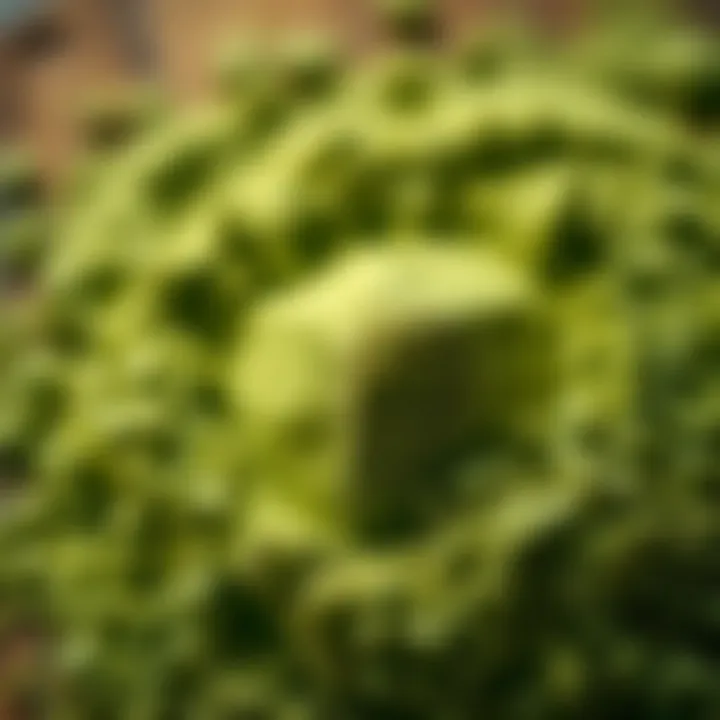
Intro
Matcha crackers have been gaining traction in the culinary world, weaving their way from traditional Japanese tea ceremonies to modern snack aisles. These delightful snacks offer an intriguing balance of flavor, nutrition, and aesthetic appeal. With the growing trend towards health-conscious eating, matcha’s incorporation into everyday foods is a topic worth exploring.
The allure of matcha lies not just in its vibrant green hue or distinctive taste, but also in its health benefits. Rich in antioxidants and known for its calming yet energizing properties, matcha is a multi-faceted ingredient. Moreover, the versatility of matcha crackers makes them a wonderful addition to various culinary contexts, whether enjoyed as a standalone snack or paired with delicious toppings.
When delving into matcha crackers, one can appreciate their roots in Japanese culture, their nutritional profile boasting health benefits, and the creative cooking techniques that can be employed. As we traverse through this exploration, we will break down the essential elements that go into crafting these crackers, uncover a myriad of variations, and tackle some common questions to enhance your experience with this snack.
Let’s begin our journey by understanding the essential components of these unique snacks, starting with the Ingredients Breakdown.
An Intro to Matcha
In the realm of culinary delights, matcha has carved a niche that is both rich in flavor and steeped in tradition. This vibrant green tea powder, made from finely ground shade-grown tea leaves, has not only invigorated the beverage scene but has also made its way into a variety of culinary applications, including our focus here—matcha crackers. This section serves as a gateway into understanding matcha's unique attributes and its journey from a ceremonial drink to a versatile cooking ingredient.
What is Matcha?
Matcha is more than just a type of green tea; it represents a cultural ritual that goes back centuries in Japan. Unlike typical tea leaves, the leaves used to produce matcha are grown in shade, enhancing their chlorophyll content and giving them a striking green hue. Once harvested, the leaves are steamed, dried, and then ground into a fine powder. This process not only preserves the leaves' nutrients but also allows for the whole leaf to be consumed, offering an unparalleled concentration of flavor and health benefits.
When it comes to taste, matcha has a unique umami flavor, often described as a combination of sweetness and bitterness with a creamy aftertaste. This distinctive profile makes it an exciting ingredient in both sweet and savory dishes. For those looking to explore a more health-conscious lifestyle, incorporating matcha into recipes can enhance dishes while adding robust flavor and a nutritional boost.
Historical Context and Cultural Significance
Understanding the history of matcha is key to appreciating its modern resurgence. Its roots trace back to China during the Tang dynasty, but it truly flourished in Japan, particularly during the 12th century when Zen Buddhist monks introduced it into their tea ceremonies as a means to enhance meditation. The Japanese tea ceremony, known as chanoyu, is not just about drinking tea; it’s an art form that cultivates mindfulness and appreciation for the moment.
Over the years, matcha’s significance has transcended the confines of these rituals. It has evolved into a symbol of healthy living, often found in trendy cafés and gourmet kitchens worldwide. As people become more health-conscious, matcha’s antioxidants and other health benefits have captured attention, making it a sought-after ingredient in a variety of culinary contexts. From matcha cortados to desserts, it continues to weave its way into diverse food cultures, adapting and transforming while retaining its essence through practice and tradition.
In essence, matcha represents a blend of artistry, health, and history, making it an ideal subject for culinary exploration. As we transition into the next sections, we will further unpack its nutritional profile, the art of crafting matcha crackers, and its potential to invigorate our kitchens with new flavors.
Nutritional Profile of Matcha
Understanding the nutritional profile of matcha is pivotal. As a highly concentrated form of green tea, matcha brings a distinct array of vitamins, minerals, and antioxidants to the table, making it not just a flavorful addition but also a powerhouse for health enthusiasts. The benefits of incorporating matcha into your diet, especially through creative avenues like matcha crackers, can't be overstated. By peeking into what lies beneath the beautiful green powder, we illuminate its varied contributions to our overall health and culinary experiences.
Vitamins and Minerals
Matcha is brimming with essential vitamins and minerals that can prove beneficial for well-being. Here are some key nutrients:
- Vitamin C: Known for its immune system support, vitamin C found in matcha may help in the maintenance of skin integrity and overall healing.
- Vitamin A: This vitamin plays a crucial role in eye health and vision, also contributing to the body’s condition.
- Iron: Essential for oxygen transport in the blood, the iron content in matcha aids in maintaining energy levels and supporting metabolic processes.
- Calcium: While not abundant, calcium in matcha supports bone health, crucial for overall physical integrity.
- Potassium: This mineral supports healthy blood pressure levels and heart function.
A single bowl of traditional matcha can provide more nutrients than many salads combined. However, it’s worth noting that while matcha is packed with these elements, consuming it in moderation is key. The combination of these vitamins and minerals is what makes matcha an interesting choice. Lift a spoonful of matcha into your morning, and you might be packing more than just flavor into your flakes.
Antioxidants and Health Benefits
Perhaps what sets matcha apart are its remarkable antioxidant properties, chiefly attributed to its high content of catechins, particularly epigallocatechin gallate (EGCG). Antioxidants are vital in fighting off free radicals, which can cause cellular damage and contribute to various diseases. Here are some insightful benefits of these antioxidants:
- Cancer-Fighting Properties: Some studies suggest that EGCG may inhibit cancer cell growth, showcasing a potential protective effect against certain cancers.
- Weight Management: Matcha is known to boost metabolism and enhance fat burning during workouts. This dual action can be quite beneficial for those monitoring their weight.
- Heart Health: Regular consumption of matcha may reduce cholesterol levels and lower blood pressure, contributing to overall cardiovascular health.
- Cognitive Function: The combination of caffeine and L-theanine found in matcha leads to improved focus and can support brain functioning, which can be particularly relevant for creative endeavors or intense work activities.
"Incorporating matcha into your daily routine may just give your health a much-needed boost."
The antioxidants found in matcha crackters not only serve a nutritional purpose but also add depth to the flavor. Pairing them with nutrient-rich dips or spreads can elevate their health benefits even more.
As we explore the depths of matcha’s nutritional offerings, it becomes clear that every crumb of these crackers can represent more than just a snack—each one can be a step toward better health.
Crafting Matcha Crackers
Crafting matcha crackers represents a delightful intersection of culinary art and health consciousness. As more individuals seek healthier snack options, these crackers emerge as a vibrant alternative that melds taste and nutrition seamlessly. The process of creating matcha crackers is not merely about following a recipe; it's about embracing a palette of flavors while harnessing the benefits of matcha itself. This segment offers a full exploration of ingredients, preparation methods, and crucial baking techniques, all designed to help culinary enthusiasts create matcha crackers that are not only appealing but also nutritious.
Ingredients Required
To embark on this culinary adventure, one must carefully select the right ingredients. Each component plays a vital role in both flavor and texture. The primary ingredient, of course, is matcha powder. It's essential to choose high-quality matcha, preferably ceremonial grade, to ensure a rich color and robust flavor.
Other ingredients typically include:
- All-purpose flour or whole wheat flour: Sets the base and provides structure.
- Butter or coconut oil: Adds richness and aids in creating a tender texture.
- Salt: Enhances flavors and balances the slightly bitter notes of matcha.
- Water: Needed to bring the dough together, adjusting the quantity as required.
Consider adding extra flavors, such as:
- Sesame seeds or chia seeds for a nutty texture.
- Herbs like rosemary or thyme for a savory twist.
- Spices like cayenne pepper for a kick.
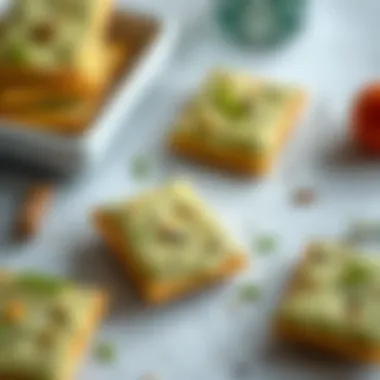
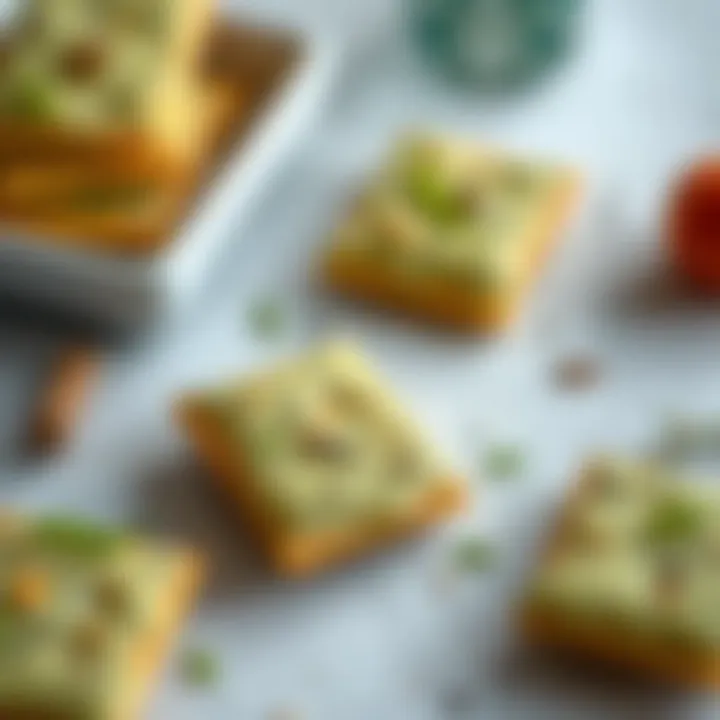
Step-by-Step Preparation Process
Creating matcha crackers can be broken down into manageable steps, allowing even novice home cooks to master their craft. Here’s a simple breakdown:
- Mix Dry Ingredients: In a large mixing bowl, whisk together flour, matcha powder, and salt. This ensures an even distribution of flavors.
- Incorporate Fat: Cut in butter or coconut oil until the mixture is crumbly. This step is crucial, as it creates flakes in the final product.
- Add Water: Gradually add cold water, stirring until a dough forms. Be careful not to overwork the dough; mixing until just combined will yield a tender cracker.
- Roll Out the Dough: Place the dough on a floured surface and roll it out to desired thickness, often around 1/8 inch.
- Cut into Shapes: Use a knife or cookie cutter to slice the dough into your preferred shapes. Remember, the thickness will affect baking time and texture.
- Transfer to Baking Sheet: Arrange the cut crackers on a parchment-lined baking sheet, spacing them a bit to allow for expansion.
Baking Techniques for Optimal Texture
When it comes to baking, mastering the technique can significantly alter the final product’s texture. Here are some tips to ensure perfect matcha crackers:
- Preheat the Oven: Always preheat the oven to prevent uneven baking. A hot oven will help the crackers puff slightly before firming up.
- Watch the Time: Generally, matcha crackers should bake for about 10–15 minutes. Keep an eye on them to avoid over-baking, which can lead to a less desirable crispy texture.
- Cool Down: After baking, let them sit on the tray for a few minutes before transferring to a wire rack. This step is pivotal for achieving a crispy finish as they continue to harden as they cool.
Crafting matcha crackers requires attention to detail, but the reward is a snack that can elevate any occasion.
As you delve into the crafting process, remember that matcha crackers are versatile and can be tailored to fit a variety of flavor profiles and dietary preferences. The journey from kitchen to table can be both fulfilling and delicious.
Variations and Flavor Combinations
Exploring the world of matcha crackers isn't just about the basic recipe; it’s an exciting journey into a realm of flavors and styles that can elevate your snacking experience. Variations and combinations of flavor profiles provide a way to customize these crackers, making them suitable for a range of palates and occasions. This flexibility allows you to adapt matcha crackers to your mood or the theme of a gathering.
Savory Matcha Crackers
Cheese and Herb Infusions
When it comes to savory matcha crackers, integrating cheese and herbs is a surefire way to hit the right notes of flavor. Cheese and herb infusions stand out as a remarkable choice, bringing a rich and aromatic quality to the table. Whether you choose sharp cheddar, creamy goat cheese, or even a sprinkle of Parmesan, the combination amplifies the umami flavor that perfectly complements the earthy notes of matcha.
The addition of herbs—like rosemary, thyme, or chives—adds a fragrant touch that can awaken the senses. Each bite is a dance of flavors, whereby the bitterness of matcha is rounded off beautifully by the creaminess of the cheese and the freshness of the herbs.
One unique feature of using this combination is that it can transform a simple cracker into a gourmet experience. However, it is crucial to balance the flavors. Too much herb can overpower the subtle matcha, so experimenting with different quantities is key to achieving the perfect harmony.
Spice Variations
Spice variations are another exciting avenue to explore in the realm of matcha crackers. Infusing a touch of heat or zing with spices like paprika, cayenne pepper, or even za'atar can change the entire character of the dish. Spice Variations essentially open doors to a myriad of culinary traditions; for instance, adding cumin can give your crackers a Middle Eastern flair.
The beauty of spice is its versatility; you can control how mild or intense the flavors become. A little pinch goes a long way, and optical effects can be achieved by combining different spices, creating a blend that will intrigue the palate. The challenge, however, lies in finding the ideal balance that allows the matcha to shine, hence why this exploration can be both thrilling and daunting.
Sweet Matcha Crackers
Chocolate Pairings
On the sweeter side of things, Chocolate Pairings take matcha crackers into a delightfully indulgent territory. The melding of matcha's earthy tones with the rich, smooth texture of chocolate creates a delicious contrast that can't be ignored. Dark chocolate, in particular, plays wonderfully with matcha's bitterness, while milk chocolate introduces a sweeter, creamier facet.
This combination is not just beneficial for flavor; it also taps into the growing popularity of sweet treats that incorporate superfoods, merging health with indulgence. A sprinkle of sea salt over the chocolate can further enhance the flavor profile, adding an unexpected crunch that rounds out the experience. The only downside might be the temptation to eat too many in one sitting—though, in the realm of indulgence, perhaps that’s not too much of a flaw.
Fruity Additions
Finally, Fruity Additions represent a refreshing turn in the matcha cracker evolution. Incorporating flavors from fruits like dried cranberries, mango, or even apple chips offers a burst of natural sweetness that pairs surprisingly well with the grassy notes of matcha. The key characteristic of this option is its ability to introduce moisture and texture, resulting in a cracker that is not just satisfying but also visually appealing.
These fruity infusions are particularly advantageous for those looking to introduce a healthier alternative. The sugars in fruits also provide a mental boost, perfect for a midday snack. Yet, one must tread carefully; ensuring that the fruits do not overshadow the matcha flavor is paramount.
Serving and Pairing Suggestions
The way matcha crackers are served can take a simple snack to new heights. Exploring various pairing suggestions opens the door to endless culinary possibilities. These suggestions are not merely to satisfy hunger; they enrich the overall experience of enjoying matcha crackers. The right accompaniments can enhance the flavor profiles and add a touch of creativity to presentations. Simply put, serving and pairing ideas are vital for anyone interested in maximizing the potential of matcha crackers.
Accompaniments for Matcha Crackers
Dips and Spreads
Dips and spreads serve as the perfect complement to matcha crackers, introducing new flavors and textures that can transform a snack into a full experience. One of the standout characteristics of using dips is how well they bridge the verdant earthiness of matcha with a range of flavors, from creamy to tangy. Popular choices range from traditional options like hummus—chickpeas blended to a smooth consistency—to zesty guacamole. These dips not only provide flavor but bring a festive element to serving.
- Unique feature: Dips allow for customization. You can mix and match flavors to suit different palettes and occasions. From robust garlic-infused spreads to herbal pesto, the choices are nearly limitless.
- Advantages: Dips often carry their own nutritional benefits, enhancing the health appeal of matcha crackers further. However, they can sometimes distract from the delicate flavor of matcha if too overpowering.
Cheese and Charcuterie Boards
Including matcha crackers on a cheese and charcuterie board elevates the dining experience dramatically. The arranged visual presentation alongside cheeses and cured meats creates a striking centerpiece that is delightful for any occasion. A distinctive feature of such boards is the harmony they create—not just in taste but in texture and color.
- Key characteristic: These boards combine the soothing earthiness of matcha with savory elements like aged cheddar or prosciutto, creating a delightful contrast. The variety of components also caters to different preferences, making it inclusive for all guests.
- Benefits: They are perfect for social gatherings, as they encourage sharing and conversation. However, it is essential to select the cheeses carefully, since some stronger cheese might overwhelm the mild flavor of matcha, thus requiring a balanced approach in selection.
Beverage Pairings
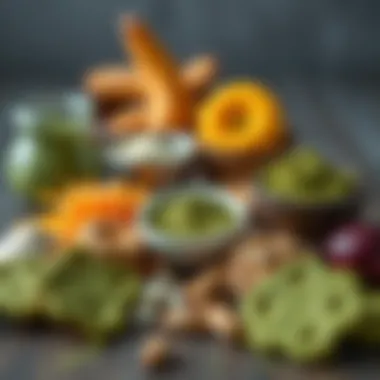
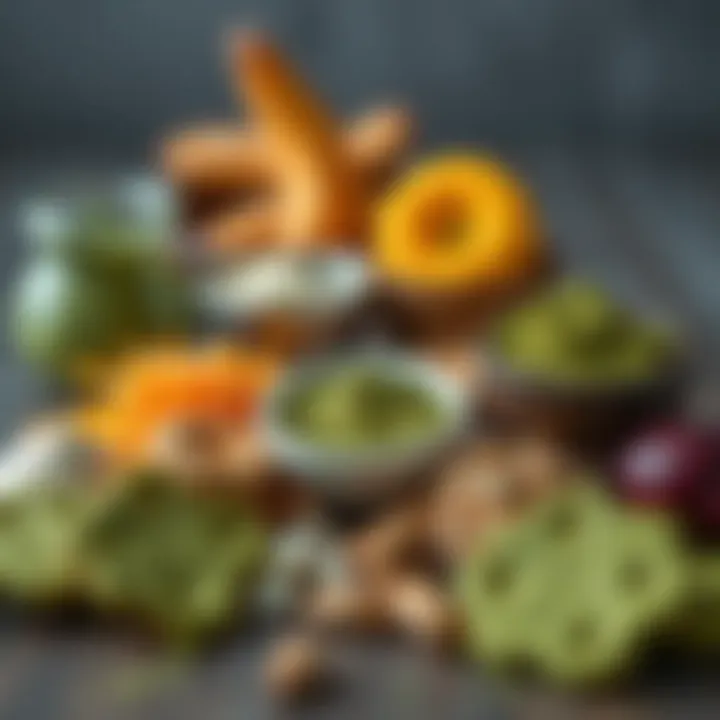
Tea Pairings
Pairing matcha crackers with teas creates a symphony of flavors for the palate. The characteristics of tea not only complement the earthy notes of matcha but also amplify the enjoyment of both. Traditional choices, such as sencha or genmaicha, can beautifully highlight the flavor dynamics at play.
- Key aspect: The ritual of enjoying matcha along with tea is deeply rooted in culture, enhancing the overall appreciation. This pairing is often seen as mutually awakening, where flavors synergize to create a mindfully calming experience.
- Unique feature: When pairing, consider the brew temperatures and steeping times, as these factors impact the interplay of flavors significantly. Additionally, over-preparing the tea can lead to bitterness, contrasting the subtle sweetness of matcha crackers.
Wine Suggestions
Wine can be a surprisingly delightful companion to matcha crackers. While you wouldn’t typically associate a green tea product with wine, certain varietals can complement the earthy and umami flavors in matcha. For instance, light white wines like Sauvignon Blanc or sparkling wines can enhance the snacking experience.
- Key characteristic: The refreshing acidity of white wines helps cleanse the palate and can provide a brighter contrast to the grassiness of matcha.
- Advantages: A well-chosen wine adds an upscale touch to serving. However, it's vital to avoid heavy reds, as they tend to overshadow the more delicate flavors of the crackers.
Culinary Applications of Matcha Crackers
The unique versatility of matcha crackers provides an exciting gateway into a world of culinary creativity. Their vibrant green hue and distinct flavor profile make them an excellent ingredient to elevate various dishes. From salads to garnishes, matcha crackers can enhance the presentation and taste of meals, bridging traditional culinary techniques with modern flair. This section will delve into two essential applications of matcha crackers in the culinary realm, offering insights on how they can be effectively utilized.
Incorporating Crackers into Salads
Utilizing matcha crackers in salads not only brings crunch but also adds a rich layer of flavor that plain croutons lack. Their slightly earthy taste complements many salad ingredients, making them a worthy substitute. Consider a mixed greens salad drizzled with a tangy vinaigrette. Adding crushed matcha crackers provides a delightful texture and an appealing visual contrast against the greens.
When incorporating them, think about the following elements:
- Flavor Harmony: Matcha’s flavor can enhance light greens like arugula or spinach, which often pair well with citrus or nutty vinaigrettes.
- Nutritional Boost: By adding matcha crackers, you’re introducing additional antioxidants and nutrients to your dish, enriching it beyond mere greens.
- Presentation: Their green color makes a striking visual impact, catching the eye and inviting guests to dig in.
To create a superb salad, consider mixing in complementary ingredients such as:
- Fruits: Slices of avocado or mandarin oranges.
- Nuts and Seeds: Almonds or sesame seeds can enhance the overall texture.
- Cheese: Crumbled feta or goat cheese gives a creamy contrast.
Using Crackers as a Garnish
Matcha crackers can elevate dishes from mundane to gourmet when used as garnishes. By breaking them into irregular pieces, they can be scattered over soups, entrées, or even canapés. Their unique profile not only adds crunch but also elevates the presentation with their rich green color.
For example, imagine a bowl of creamy butternut squash soup, garnished artistically with matcha cracker shards. This not only adds depth to the plate but also invites the eater to enjoy a contrast of textures and flavors. Here are some ideas for using matcha crackers as a garnish:
- Soups and Stews: Use them to add texture and an unexpected taste twist.
- Artisan Sandwiches: Sprinkle crushed matcha crackers inside for an added crunch.
- Stuffed Vegetables: Top stuffed bell peppers with crushed matcha for a colorful finish.
In the realm of creativity, the possibilities are endless. Matcha crackers are not just edible snacks; they're a means to enhance the culinary experience, bringing sophisticated flavor and texture to various culinary creations.
Health Considerations
Understanding health considerations when it comes to matcha crackers is crucial for those who wish to elevate their snacking experience while also being mindful of their dietary choices. The growing awareness around health and nutrition has sparked interest in gluten-free options and the broader nutritional value of ingredients like matcha. With this in mind, it becomes apparent that matcha crackers present a unique opportunity to indulge in a delightful snack without compromising on health.
Gluten-Free Options
In recent years, gluten sensitivity has led many individuals to seek out gluten-free alternatives. Matcha crackers can easily fit into this category, particularly when crafted using ingredients that are naturally devoid of gluten. For instance, using rice flour or almond flour in the batter provides a crunchy texture without the presence of gluten, making these crackers accessible to those with dietary restrictions. This can be particularly appealing for people with celiac disease or gluten intolerance, further broadening the appeal of matcha crackers to a wider audience.
Here are a few popular gluten-free flour alternatives to consider:
- Rice Flour: This is a staple in Asian cuisine and lends a light, crispy texture to your crackers.
- Almond Flour: Rich in protein and healthy fats, it adds a subtle nuttiness.
- Chickpea Flour: Offers a semi-sweet finish, adding depth to flavors.
Choosing these flour bases allows for not just gluten-free options but also a variety of textures and tastes in matcha crackers. By ensuring that matcha crackers can be gluten-free, consumers can enjoy them without any dietary hesitations, keeping everyone's needs in mind.
Nutritional Value in Context
When you bite into a matcha cracker, you are not merely savoring a crunch; you are also introducing a mix of nutrients into your diet. Matcha itself is lauded for its impressive nutritional profile, containing a wealth of antioxidants and a notable concentration of vitamins and minerals. This makes it a fitting ingredient for health-conscious snacks.
Here are some key components of matcha that should hold the spotlight:
- Antioxidants: Matcha is packed with catechins, particularly epigallocatechin gallate (EGCG), which are known for their health benefits including anti-inflammatory properties and improved metabolism.
- Vitamins: It contains a good amount of vitamins A, C, and E, crucial for maintaining skin health and boosting the immune system.
- Minerals: Elements like potassium, calcium, and magnesium play vital roles in various bodily functions, including muscle contraction and nerve function.
By incorporating matcha into cracker recipes, you can create a snack that is satisfying on multiple levels—taste, crunch, and nutritional value.
Sourcing Quality Matcha
When diving into the world of matcha crackers, one pivotal aspect often overlooked is the sourcing of quality matcha. The purity and quality of matcha can significantly influence not only the flavor but also the health benefits that these vibrant green crackers can offer. Selecting matcha is akin to choosing the right wine; the source, grade, and processing methods all contribute to the depth of flavor and overall experience.
Identifying Authentic Matcha
Authentic matcha is a product steeped in tradition and finesse. To ensure you’re not falling victim to mislabeling, observe a few key characteristics:

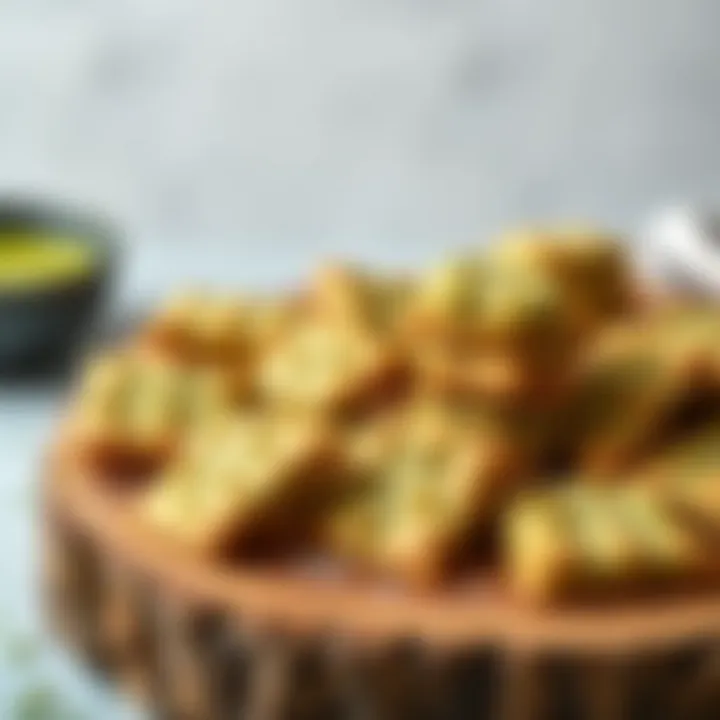
- Color: Genuine matcha boasts a bright, vibrant green color, which indicates high chlorophyll levels from shade-grown tea leaves. If it appears dull or yellowish, it’s often a sign of lower quality.
- Texture: High-quality matcha is finely ground and feels silky smooth, rather than gritty when rubbed between your fingers.
- Aroma: When you open a tin of matcha, the fragrance should be fresh and grassy. A stale or dusty scent often signals inferior quality.
- Origin: Look for matcha sourced from regions known for high-quality production such as Uji in Japan. Each region has its unique flavor profile, influenced by the soil, weather, and cultivation methods.
- Certifications: Always check for food safety certifications or organic labels, as these can provide additional assurance regarding the purity of the matcha.
"Not all green powders are created equal. Authentic matcha can unlock a depth of flavor and health benefits that other green tea powders simply can’t match."
Understanding Grades of Matcha
Matcha is typically categorized into various grades, each distinguished by its quality and intended use:
- Ceremonial Grade: This is the top-tier matcha, used in traditional tea ceremonies. It has a rich flavor and vibrant color that make it perfect for drinking straight, often whisked with water for a smooth beverage.
- Premium Grade: Slightly lower than ceremonial, this grade is still suitable for direct consumption, often appreciated for its rich taste and fine texture.
- Culinary Grade: Ideal for cooking and baking, including matcha crackers, this grade tends to have a more robust flavor that can withstand other ingredients. It’s commonly found in shops for those looking to incorporate matcha into various recipes.
When venturing into the realm of matcha, understanding these nuances helps in selecting the best matcha suited for making delectable crackers. Better quality matcha not only elevates taste but also maximizes the nutritional benefits, giving you more bang for your buck.
The Science Behind Matcha
Understanding the science behind matcha is not just an academic endeavor but an essential part of appreciating its multifaceted benefits, especially when it comes to cooking matcha crackers. Matcha is more than just finely ground green tea leaves; it is a powerhouse of nutrients that can elevate a simple snack into a health-focused treat. Knowing how matcha works in the body, especially its effects on metabolism and the unique properties of L-Theanine, is vital for anyone looking to incorporate this ingredient effectively into their kitchen.
How Matcha Affects Metabolism
Matcha's impact on metabolism is one of its most compelling qualities. This green tea powder contains catechins, a form of antioxidants, particularly epigallocatechin gallate (EGCG), which is known for its ability to enhance metabolic rate. When you consume matcha, it stimulates thermogenesis—the natural process your body uses to generate heat and energy from digesting food. This means that your body burns more calories even at rest, making it a good ally for weight management.
Research shows that drinking matcha can lead to increased fat oxidation, especially during physical activity. So, whether you're whipping up a batch of matcha crackers for a midday snack or as a part of a protein-rich meal, you might just be giving your metabolism a little boost at the same time.
- In one study, participants who consumed matcha saw a 17% increase in fat burning during 30 minutes of exercise. This is quite significant, showcasing that even moderate consumption of matcha can have a positive impact.
- Additionally, the caffeine in matcha aids in enhancing performance during workouts, helping you to push just a bit harder when preparing a fresh batch of delectable crackers.
"Just like fire needs oxygen to thrive, your metabolism requires specific compounds found in matcha to function optimally."
The Role of L-Theanine
In addition to catechins, another intriguing component of matcha is L-Theanine, an amino acid that works wonders for both the body and the mind. This compound is known for promoting relaxation and reducing stress levels. When preparing your matcha crackers, the calming effects of L-Theanine can help cultivate a sense of well-being that transforms a simple snack into a mindful experience.
L-Theanine encourages the production of alpha waves in the brain, which can lead to improved focus and mental clarity. This means that while you’re perhaps enjoying your matcha snack, you’re also sharpening your mind. Thus, incorporating matcha into your diet doesn’t just cater to your taste buds; it enhances cognitive function as well.
- When people enjoy matcha, they often describe a gentle alertness rather than the jitteriness that can accompany coffee consumption. This makes it excellent for feeling sharp during your afternoon work session.
- Furthermore, the synergy between caffeine and L-Theanine found in matcha is distinct. This powerful duo provides a stable energy release without the crash, making your matcha crackers not just a mere snack but a potential enhancer of your productivity.
In summary, recognizing how matcha interacts with your body's metabolism and its neuroprotective properties allows you to appreciate the snack you are creating on a deeper level. Whether you’re adding matcha for the flavor or health benefits, understanding these underlying scientific principles can guide you to make the most of your culinary pursuits.
Cultural Perspectives on Matcha
Matcha isn't just a green powder; it holds a treasure trove of cultural significance that stretches across centuries and continents. In this section, we’ll unravel how matcha is not only enjoyed but also revered across various traditions. Its journey from ancient tea ceremonies in Japan to its present-day global adaptations reveals insights into the social fabric that binds communities through shared culinary experiences.
Global Adaptations of Matcha
With the world bustling about, matcha has transcended its Japanese roots, finding a cozy spot in the hearts and kitchens of many. In places like the West Coast of the United States, matcha lattes have become a staple in coffee shops, while Australian cafes often offer matcha-infused bakery items. This green delight has been embraced in unique ways, adapting to local palates and culinary practices. For instance:
- Matcha Tiramisu: An Italian classic gets a green twist with matcha layers, creating a fusion of flavor that speaks volumes about culinary creativity.
- Matcha Cheesecake: In New York, this has become a must-have dessert, blending the richness of cheesecake with the earthy notes of matcha.
These adaptations showcase how culinary traditions evolve, reflecting local ingredients and tastes while maintaining respect for matcha’s origins.
Matcha in Modern Cuisine
Entering the realm of modern gastronomy, matcha has firmly planted itself as a versatile ingredient that chefs and home cooks alike can’t resist. From ice cream to sauces, the possibilities are nearly endless. In contemporary cooking, the use of matcha is often accompanied by a desire to explore health-conscious options. The intrinsic benefits of matcha—like its antioxidant properties—play a significant role in this culinary trend. Some innovative applications include:
- Savory Dishes: Chefs utilize matcha as a seasoning in dressing or marinades, giving an umami punch that echoes in dishes like roasted meats or grilled vegetables.
- Baked Goods: Beyond crackers, matcha has become a beloved ingredient in muffins, pancakes, and even bread, adding a subtle flavor and a striking color to the final product.
"Matcha isn't just a trend; it's a bridge connecting cultures through cuisine, inviting everyone to partake in its rich story."
As matcha continues to capture interest, its place in modern cuisine signifies openness to fusion, leading to numerous innovative recipes and pairings. The trajectory of matcha reflects broader culinary shifts embracing health, flavor, and sustainability. As food lovers explore these paths, they not only savor exquisite flavors but also partake in a global dialogue—one that celebrates diversity and tradition through the lens of matcha.
Closure: The Future of Matcha Crackers
As trends in the culinary world continuously evolve, matcha crackers stand at the crossroads of tradition and innovation. The growing interest in health-conscious snacks and cultural cuisines positions these uniquely flavored crackers to take a more prominent role in everyday diets. What makes this topic significant is not merely the variety of flavors or health benefits; it’s how matcha crackers symbolize a broader shift towards incorporating health-fortified ingredients into snacks. The emphasis on natural ingredients and artisanal methods aligns neatly with contemporary preferences, reflecting a commitment not just to taste but to overall wellness.
Trends in Matcha-Based Snacks
One clear trend in the realm of matcha-based snacks is the increasing fusion with other culinary traditions. The classic matcha flavor, while cherished, is now being elevated through combinations with spices, nuts, and even superfoods like chia seeds. Consumers are on the lookout for snacks that are not only healthy but also diverse in flavors and textures. Many brands are experimenting with combining matcha with other botanical flavors, such as hibiscus or lemongrass, creating a refreshing twist that appeals to a wider audience. This embrace of unique pairings signals an evolution, where matcha snacks are no longer confined to traditional boundaries but are instead adapting to modern palates.
"The future of matcha snacks is a canvas for culinary creativity, blending time-honored traditions with the bold flavors of today."
Additionally, sustainability is increasingly becoming a selling point. Many producers are emphasizing eco-friendly sourcing and packaging. As a result, consumers are not just purchasing a product but also supporting ethical practices, which enhances their overall experience and aligns with their values. The introduction of seasonal flavors is also a noteworthy trend. Limited-edition matcha crackers infused with flavors like pumpkin spice in the fall or peppermint in the winter can create excitement and encourage repeat purchases as consumers eagerly await new offerings.
Incorporating Innovation in Traditional Techniques
The craftsmanship behind matcha crackers opens up avenues for innovation, as many cooks and bakers are rediscovering ancient techniques and adapting them for contemporary use. Classic methods, like stone grinding for matcha powder, are now finding their way into the production process for crackers, enhancing flavor while respecting tradition.
Moreover, new technologies are being embraced, like dehydrators and modern ovens that allow for precise temperature control, ensuring a consistent texture and taste. Use of alternative flours, such as almond or coconut, in place of traditional wheat flour is also gaining traction, catering to various dietary requirements, including vegan and gluten-free lifestyles. The incorporation of matcha into unexpected dishes, like matcha-infused hummus or savory biscuit mixes, showcases how traditional techniques can give rise to innovative products that capture the imagination of food lovers.







